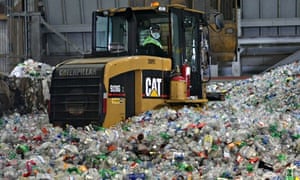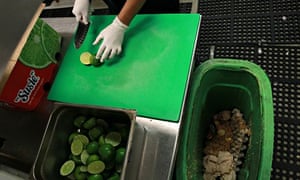The trucks start rolling in before sunrise. Dozens of them, each tipping out tonnes of food waste, grass cuttings and foliage. A month from now this organic waste will leave here in the form of rich compost, as fine as sand.
Here, in Vacaville, an hour by road north of San Francisco, is an essential part of the city's scheme to eliminate waste that is neither recycled nor composted by 2020, thus doing away with the need for landfill and incinerators – both major sources of pollution.
To attain this goal – which no other city in the world of comparable size has done – San Francisco (population 840,000) has displayed great political determination, backed by a raft of legislation. Its latest move is to ban the sale or distribution of small plastic bottles of water on public property – except for big events such as Gay Pride. Instead, the city authorities plan to install drinking fountains. Compostable cups will be handed out at large gatherings.
"There are incredible, enormous environmental costs of plastic water bottles. It takes 1,000 years for a typical plastic water bottle to biodegrade," said David Chiu, president of the board of supervisors, who introduced the measure. "If we can do this on public property and folks understand this is absolutely doable, then we can look at next steps." In other words, consider an overall ban.
San Francisco has adopted this step-by-step method since the Zero Waste schemewas decided in 2002. "California had already set a target for 50% recycling [of solid waste] by 2010. But we wanted to go further," says Jared Blumenfeld, former head of San Francisco's department of the environment and now Environmental Protection Agency regional administrator for the Pacific south-west. "We agreed on an ambitious zero-waste target and then on a date, which was far enough away for us to find the means of achieving it, but close enough for everyone to feel immediately concerned." The target was set for 2020, with a 75% step on the way in 2010.
Which left a great deal to do. "People said we were crazy," Blumenfeld acknowledges with a smile. But a study carried out at the time showed that 90% of the waste ending up in landfill could be recycled and that the largest share was food. "We don't see waste as a burden, rather as a resource which can be used," says Robert Reed, head of public relations at Recology, the employee-owned company that collects and processes San Francisco's waste.
So the department of the environment started by targeting the city's hotels and restaurants, which produce a lot of organic waste. "We started with a test hotel, the Hilton, which serves 7,500 meals a day, and we set up a simple system: collection carts containing recyclable or compostable material cost much less a month on the bill than those containing non-recyclable waste," Blumenfeld explains. "If you recycle and compost all your waste, you will need fewer, or much smaller, trash carts. And you'll save money."
The system was a success. In the first year the Hilton saved $200,000, and the scheme was extended to the whole catering industry. It was also made available to residents, but on a voluntary basis. "In four years, from 2001 to 2005, we went from 42% recycled waste to 60%," Blumenfeld explains.
One of the less visible but nevertheless important categories of waste encompasses all the debris produced by the construction industry. In 2006, after negotiations lasting two years, the then mayor, Gavin Newsom, introduced the mandatory construction and demolition debris recovery ordinance, requiring the building trade to recycle at least two-thirds of its debris such as concrete, steel and timber at a registered facility. Companies failing to comply run the risk of their registration being suspended for six months. At the same time, the city undertook to only use recycled materials for public works such as asphalting or gutters.
But this was not enough. In 2007-08 the rate of waste diversion, or recovery, flattened out at about 70%, whereas the city had set a target of 75% by 2010. So the city introduced two additional measures, which impacted directly on the daily lives of residents.Supermarkets were no longer allowed to provide free plastic bags. Paper or compostable plastic bags were charged for, to encourage shoppers to reuse their own bags.
Then, in 2009, recycling and composting became compulsory for all residents. The same system applied as for the catering trade: each house or building received a detailed bill, which could be cut by reducing use of trash carts, shifting waste to those set aside for recycling or composting. These rules are backed by regular checks. Those who fail to comply receive warnings, followed by fines ranging from $100 to $1,000.
"That was the most controversial measure," Blumenfeld admits. "We were accused of setting up an environmental police force. We spent a long time explaining that there was no question of that, and that everyone stood to gain. If we'd made this mandatory straight away, it wouldn't have worked. It had to be gradual."
The effort was worth it: in 2010 the city achieved a 77% diversion rate and has since topped 80%. Every day about 600 tonnes of organic waste is recovered and sent to the Vacaville facility, which now produces compost highly prized by farmers, such as Dave Vella, vineyard manager at Chateau Montelena winery in Napa Valley. "The compost is very rich, because it consists of a wide range of organic waste, and thoroughly beneficial," he says. "It fixes the carbon in the soil and gives the vine plenty of nutrients."
Vella has been using Recology compost for almost 10 years. At the outset it was quite a wager for a vineyard that came to international attention in 1976 when it outdid French wines to win the Paris Wine Tasting.
"I was scared stiff at the idea it might change the wine," Vella recalls. "I started by testing the compost on a small area of the domain, then I gradually extended it, because the wine was better and the soil was healthier."
San Francisco is still some way short of its 100% target, and the last mile is always the hardest. "We'll make it," Reed asserts. "Half the waste still going to landfill could be recycled. We need to step up our efforts, like raising residents' awareness that they recycle plenty in the kitchen, but often only have one trashcan in the bathroom."
"We must take action at source too," he adds, "targeting packaging – like the ban on polystyrene and cellophane – and developing the use of washable, reusable diapers, because that's a form of waste we can't recycle."
Whatever the results in 2020, San Francisco has made a huge effort, setting an example for other big US cities to follow. Seattle has adopted the 100% target and now Minneapolis has decided to follow suit, though currently it only recycles 37% of its waste.
This article appeared in Guardian Weekly, which incorporates material from Le Monde



Nessun commento:
Posta un commento